
Trail blazing
Encyclopedia

Recreation
Recreation is an activity of leisure, leisure being discretionary time. The "need to do something for recreation" is an essential element of human biology and psychology. Recreational activities are often done for enjoyment, amusement, or pleasure and are considered to be "fun"...
al areas with blazes, markings that follow each other at certain — though not necessarily exactly defined — distances and mark the direction of the trail. In older times, a tree could be blazed by hatchet chops, while today other methods have become more common, with environmental
Environmentalism
Environmentalism is a broad philosophy, ideology and social movement regarding concerns for environmental conservation and improvement of the health of the environment, particularly as the measure for this health seeks to incorporate the concerns of non-human elements...
concerns sometimes playing a part in the choice of blazing method.
Types
There are many methods used for blazing trails, with each often having their advantages and disadvantages.Paint blazes
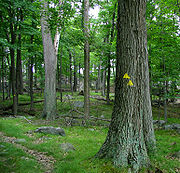
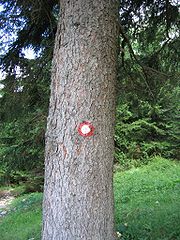
Paint
Paint is any liquid, liquefiable, or mastic composition which after application to a substrate in a thin layer is converted to an opaque solid film. One may also consider the digital mimicry thereof...
ed marking of a consistent shape or shapes (often rectangular
Rectangle
In Euclidean plane geometry, a rectangle is any quadrilateral with four right angles. The term "oblong" is occasionally used to refer to a non-square rectangle...
), dimension and color or combination of colors is used along the trail route. The system by which blazes are used to signify turns and endpoints in trails (see below) strongly favors the use of paint blazes. Commonly, in North America
North America
North America is a continent wholly within the Northern Hemisphere and almost wholly within the Western Hemisphere. It is also considered a northern subcontinent of the Americas...
, to avoid confusion, it is one single color, often white, red, blue or yellow. Other trails, especially in Europe, may use more complex systems of painted shapes in more than one color. Some Austrian trails, for example, use a combination of white and coloured stripes, while Middle European countries such as Czech Republic
Czech Republic
The Czech Republic is a landlocked country in Central Europe. The country is bordered by Poland to the northeast, Slovakia to the east, Austria to the south, and Germany to the west and northwest....
, Slovak Republic and Poland
Poland
Poland , officially the Republic of Poland , is a country in Central Europe bordered by Germany to the west; the Czech Republic and Slovakia to the south; Ukraine, Belarus and Lithuania to the east; and the Baltic Sea and Kaliningrad Oblast, a Russian exclave, to the north...
use colored bars with different meanings attached to different colors.
When using paint on trees, the preferred technique is to use a drawknife
Drawknife
A drawknife is a traditional woodworking hand tool used to shape wood by removing shavings. It consists of a blade with a handle at each end. The blade is much longer than it is deep...
to smooth the outer bark
Bark
Bark is the outermost layers of stems and roots of woody plants. Plants with bark include trees, woody vines and shrubs. Bark refers to all the tissues outside of the vascular cambium and is a nontechnical term. It overlays the wood and consists of the inner bark and the outer bark. The inner...
of trees without penetrating to the inner bark (so as to not injure the tree), then using an oil-based paint to create the blaze. Since paint introduces small amounts of potentially toxic chemicals into a protected environment, it is often preferred to keep the blazes small. Stencils are often useful, and sash brushes are the preferred brush type for precise work. Oil-based paint seems to last longer than latex-based and seems to be more benign to the bark. Blazes may also be painted on obvious rock surfaces or on posts set into the ground (or on utility poles, fences, or other handy surfaces) where the trail follows a road or goes through fields and meadows.
Affixed markers
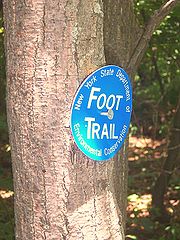
Plastic
A plastic material is any of a wide range of synthetic or semi-synthetic organic solids used in the manufacture of industrial products. Plastics are typically polymers of high molecular mass, and may contain other substances to improve performance and/or reduce production costs...
, metal
Metal
A metal , is an element, compound, or alloy that is a good conductor of both electricity and heat. Metals are usually malleable and shiny, that is they reflect most of incident light...
or even sometimes wood
Wood
Wood is a hard, fibrous tissue found in many trees. It has been used for hundreds of thousands of years for both fuel and as a construction material. It is an organic material, a natural composite of cellulose fibers embedded in a matrix of lignin which resists compression...
en markers may be affixed to trees, usually by nails
Nail (engineering)
In woodworking and construction, a nail is a pin-shaped, sharp object of hard metal or alloy used as a fastener. Formerly wrought iron, today's nails are typically made of steel, often dipped or coated to prevent corrosion in harsh conditions or improve adhesion...
. These last longer than paint, but are vulnerable to both the chewing of animals (porcupine
Porcupine
Porcupines are rodents with a coat of sharp spines, or quills, that defend or camouflage them from predators. They are indigenous to the Americas, southern Asia, and Africa. Porcupines are the third largest of the rodents, behind the capybara and the beaver. Most porcupines are about long, with...
s especially) and the growth of the tree swallowing the nails and causing the marker to fall off. To protect against this possibility, most markers are put on nails with some space between the head and the bark. The placement of markers requires more skill and labor than paint, as well as an area with an abundant supply of trees to which to attach them.
Flagging
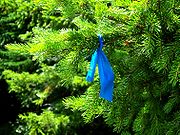
Surveying
See Also: Public Land Survey SystemSurveying or land surveying is the technique, profession, and science of accurately determining the terrestrial or three-dimensional position of points and the distances and angles between them...
's tape hung from branches or tied around trees is sometimes used to indicate trail routes, but usually only for temporary or unofficial trails, most commonly when a trail route has been selected but the trail itself is under construction. They are sometimes used for permanent trails, but they are the most vulnerable to the elements of any trail blazing method and may be more difficult to see.
Cairns

Alpine climate
Alpine climate is the average weather for a region above the tree line. This climate is also referred to as mountain climate or highland climate....
s, where no trees are available and painting on rocks is often done but either would not last or are not always easy to see. In the Presidential Range
Presidential Range
The Presidential Range is a mountain range located in the White Mountains of the U.S. state of New Hampshire. Containing the highest peaks of the Whites, its most notable summits are named for American Presidents, followed by prominent public figures of the 18th and 19th centuries.Mt...
of New Hampshire
New Hampshire
New Hampshire is a state in the New England region of the northeastern United States of America. The state was named after the southern English county of Hampshire. It is bordered by Massachusetts to the south, Vermont to the west, Maine and the Atlantic Ocean to the east, and the Canadian...
's White Mountains
White Mountains (New Hampshire)
The White Mountains are a mountain range covering about a quarter of the state of New Hampshire and a small portion of western Maine in the United States. Part of the Appalachian Mountains, they are considered the most rugged mountains in New England...
, for example, cairns are found at ten-foot (three-meter) intervals along trails above treeline, so that hikers forced to crawl by heavy winds and occasional infamously lethal weather can find their way to safety.
Below treeline, cairns are used less frequently, often like flagging to indicate informal or unofficial paths or just their junctions with official trails. They are the least visually intrusive and most environmentally friendly blazing method. However, their construction requires sufficient stones be either available in the area or brought to the trail. They may become obscured by snow
Snow
Snow is a form of precipitation within the Earth's atmosphere in the form of crystalline water ice, consisting of a multitude of snowflakes that fall from clouds. Since snow is composed of small ice particles, it is a granular material. It has an open and therefore soft structure, unless packed by...
in areas with heavy winters and may be easily knocked over.
In the United States
United States
The United States of America is a federal constitutional republic comprising fifty states and a federal district...
, Scotland
Scotland
Scotland is a country that is part of the United Kingdom. Occupying the northern third of the island of Great Britain, it shares a border with England to the south and is bounded by the North Sea to the east, the Atlantic Ocean to the north and west, and the North Channel and Irish Sea to the...
, and other parts of the world, it is traditional for walkers to add a stone to cairns as they pass. This particularly applies to summit cairns.
Carved blazes
.jpg)
Axe
The axe, or ax, is an implement that has been used for millennia to shape, split and cut wood; to harvest timber; as a weapon; and as a ceremonial or heraldic symbol...
or knife
Knife
A knife is a cutting tool with an exposed cutting edge or blade, hand-held or otherwise, with or without a handle. Knives were used at least two-and-a-half million years ago, as evidenced by the Oldowan tools...
, usually the former. Most often these are informal routes made by loggers
Logging
Logging is the cutting, skidding, on-site processing, and loading of trees or logs onto trucks.In forestry, the term logging is sometimes used in a narrow sense concerning the logistics of moving wood from the stump to somewhere outside the forest, usually a sawmill or a lumber yard...
or hunters
Hunting
Hunting is the practice of pursuing any living thing, usually wildlife, for food, recreation, or trade. In present-day use, the term refers to lawful hunting, as distinguished from poaching, which is the killing, trapping or capture of the hunted species contrary to applicable law...
, or trails descended from those routes. Due to the maintenance and skill required, as well as an increasing aversion to harming trees, this method is almost never used today, although in past centuries it was often the only method used.
Degree
The amount of blazing used on a trail is often impacted by different land-management principles, as well as the kind of users the trail is likely to get and what kind of trail it is in the first place. In U.S. wilderness areas, whether state or federal, the U.S. Wilderness ActWilderness Act
The Wilderness Act of 1964 was written by Howard Zahniser of The Wilderness Society. It created the legal definition of wilderness in the United States, and protected some 9 million acres of federal land. The result of a long effort to protect federal wilderness, the Wilderness Act was signed...
requires that the land seems "untrammeled by man," and so blazes are often kept to a minimum. Most wilderness trails are also used by serious hikers and backpackers
Backpacking (wilderness)
Backpacking combines the activities of hiking and camping for an overnight stay in backcountry wilderness...
who may find excessive blazing to be visually annoying or distracting.
By contrast, in a typical municipal or county
County
A county is a jurisdiction of local government in certain modern nations. Historically in mainland Europe, the original French term, comté, and its equivalents in other languages denoted a jurisdiction under the sovereignty of a count A county is a jurisdiction of local government in certain...
park
Park
A park is a protected area, in its natural or semi-natural state, or planted, and set aside for human recreation and enjoyment, or for the protection of wildlife or natural habitats. It may consist of rocks, soil, water, flora and fauna and grass areas. Many parks are legally protected by...
, or any land open to a wide variety of users, especially one where overnight camping
Camping
Camping is an outdoor recreational activity. The participants leave urban areas, their home region, or civilization and enjoy nature while spending one or several nights outdoors, usually at a campsite. Camping may involve the use of a tent, caravan, motorhome, cabin, a primitive structure, or no...
is either forbidden or infrequent (for example, if it is located in a well-developed metropolitan area), one can expect much more casual users who are not used to finding trails and appreciate frequent blazes.
Single-track trails of the sort favored by those on foot also receive more blazes than those that follow old roads or other wide routes, which are often self-evident and are thus usually blazed only as necessary to infrequently reassure travelers of the route they have chosen.
Systems
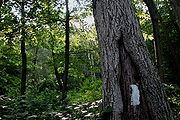
Mount Greylock
Mount Greylock is the highest natural point in Massachusetts at . Its peak is located in the northwest corner of the state in the western part of the town of Adams in Berkshire County. Although geologically part of the Taconic Mountains, Mount Greylock is commonly associated with the abutting...
State Reservation, which contains the highest mountain in Massachusetts
Massachusetts
The Commonwealth of Massachusetts is a state in the New England region of the northeastern United States of America. It is bordered by Rhode Island and Connecticut to the south, New York to the west, and Vermont and New Hampshire to the north; at its east lies the Atlantic Ocean. As of the 2010...
, all trails other than the Appalachian Trail use the same blue blaze (pictured below in the gallery).
Blaze type might also be mixed when different user groups (i.e., snowmobile
Snowmobile
A snowmobile, also known in some places as a snowmachine, or sled,is a land vehicle for winter travel on snow. Designed to be operated on snow and ice, they require no road or trail. Design variations enable some machines to operate in deep snow or forests; most are used on open terrain, including...
rs, horse riders
Equestrianism
Equestrianism more often known as riding, horseback riding or horse riding refers to the skill of riding, driving, or vaulting with horses...
, mountain bike
Mountain bike
A mountain bike or mountain bicycle is a bicycle created for off-road cycling. This activity includes traversing of rocks and washouts, and steep declines,...
rs) are allowed on trails. For users of faster vehicles, blazes are often more outsized in order to be seen better at high speeds, and sometimes affixed markers best communicate who may and may not use a trail besides those on foot.
Another possible distinction is by season. In Norway, it is common to use blue for summer routes and red for winter routes. Red routes may traverse lakes ands swamps, which are flat and well suited for cross-country skiing in winter, but impassable on foot in summer.
Colors are often assigned simply with an eye toward making sure that no two trails that intersect use the same one, but it can go further than that. On all state land in New York
New York
New York is a state in the Northeastern region of the United States. It is the nation's third most populous state. New York is bordered by New Jersey and Pennsylvania to the south, and by Connecticut, Massachusetts and Vermont to the east...
's Catskill Park, for instance, primary trails, especially longer "trunk trails" that go great distances, use red markers if they go in a generally east-west direction and blue if they go north-south. Shorter spur, loop or connector trails generally use yellow blazes.
On occasions when two trails run concurrently, usually at a slightly staggered junction, only one trail may be signed, often with the longer or more heavily trafficked trail's blaze predominating. In other cases, such as southern Vermont
Vermont
Vermont is a state in the New England region of the northeastern United States of America. The state ranks 43rd in land area, , and 45th in total area. Its population according to the 2010 census, 630,337, is the second smallest in the country, larger only than Wyoming. It is the only New England...
where the Appalachian Trail and the Long Trail
Long Trail
The Long Trail is a hiking trail located in Vermont, running the length of the state. It is the oldest long-distance trail in the United States, constructed between 1910 and 1930 by the Green Mountain Club...
follow the same path, both trails may use the same white blaze.
Meaning of blazes

Hairpin turn
A hairpin turn , named for its resemblance to a hairpin/bobby pin, is a bend in a road with a very acute inner angle, making it necessary for an oncoming vehicle to turn almost 180° to continue on the road. Such turns in ramps and trails may be called switchbacks in American English, by analogy...
, and where trails begin and end.
Volunteers working in Harriman State Park in the 1930s for the newly-formed New York – New Jersey Trail Conference developed a system whereby a vertically stacked pair of blazes, with the upper one generally offset in the direction that the trail turns; a triangular pattern of blazes would indicate a terminus, its point up or down depending on whether that was the beginning or the end. These began to be used elsewhere and are now fairly common throughout North America, though variations of this system exist. Some trails instead use two blazes painted together an an angle to form an "L" shape to indicate a turn, with the angle between the two blazes indicating the angle and direction of the turn. Also, a few trails indicate turns with two stacked blazes, without an offset, but this can cause confusion as the direction is not implied. In addition, other trails may use two non-offset stacked blazes indicate the trail goes strait at a location where there may be tempting mis-turn.
A triangular pattern with its point to the side was also devised for eventualities like spurs or junctions, but these have not caught on.
In some areas, a triangular pattern with its point up indicates that a hiker is at the point of a sharp switchback.
As noted above, this system does much to encourage the use of paint blazes. Markers can also follow these patterns, but they less frequently use them. It cannot be used with cairns or tape flags, and not easily with carved blazes.

